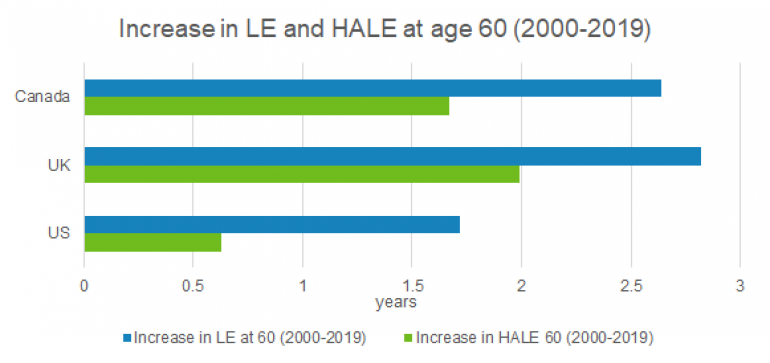Before the pandemic put an end to group activities, the last part of my spinning class would consist of a series of stretches. Whenever the trainer would begin this section, I would pause and remember the wise advice of my physiotherapist “choose quality over quantity” and I would opt to do my own series of a smaller number of longer duration (higher quality) stretches.
Now I wonder if the quality over quantity argument will influence the push to increase healthy life expectancy more rapidly than total lifespan.
Where are we now?
First let’s define the term. According to the World Health Organization (WHO), healthy life expectancy is the average number of years a person can expect to live in “full health”, (without disease or injury), also commonly known as Health Adjusted Life Expectancy (HALE).
The WHO’s Global Health Estimates show the progression of both life expectancy (LE) and HALE at age 60 between 2000 and 2019 for Canada, UK and US combined for women and men.
|
| LE at age 60 | HALE at age 60 |
| Canada | From 22.51 to 25.15 | From 17.32 to 18.99 |
| UK | From 21.31 to 24.13 | From 16.26 to 18.25 |
| US | From 21.41 to 23.13 | From 15.72 to 16.35 |

Source: The WHO’s Global Health Estimates
These figures reveal a consistent pattern of the latest elderly generation spending more time at the end of their lives in frail health across all three countries. Is it possible that the next generation can turn this around?
Where are we going?
We all know that there are many tailwinds and headwinds affecting both life expectancy and healthy life expectancy. My vision for the next 20 years is that the gap between HALE and LE in the US, UK and Canada will narrow. In other words, that improving the quality of life will be valued more than improving the quantity of life.
My prediction is based on my assessment of the Baby Boomer generation, a fascinating generation for someone from the generation just after. I consider the Baby Boomer generation as those born between 1946 and 1964. There was a large boom in births in this era (following the second world war and before the widespread availability of contraception) resulting in a generation much larger than those before and after. People of this generation are currently aged between their mid-fifties and their mid-seventies, so will have a large influence on the next steps for both LE and HALE.
Baby Boomers became adults during a time of unprecedented prosperity and triggered dramatic social change. They are often portrayed as experimental, embracing of technology and new culture and having an anti-establishment attitude.
Let’s look at a few angles to determine the score between increases in quality of life quality and quantity of life.
A look at demography
The demographic impact of the massive Baby Boomer generation reaching older age will certainly put more pressure on our health systems. Will they cope with the increased demand (and potentially increased costs and labor shortages) due to the shift to an older population with more health conditions?
Potentially there could be a vicious circle of more health costs being borne by a smaller tax-paying population, resulting in a lower quality of care.
How will the government react to this increased demand? Could they focus on providing more “home care” assisted services ? Could they focus on prevention by increasing taxes on “unhealthy” products which could have economic repercussions?
Demography scores 1 point to Quantity
A look at health
With the population aging, the challenges associated with the “graying of disability” – people with disabilities living longer than in the past - will likely continue and even increase as time goes by.
Is the Baby Boomer generation in better health at retirement than the prior generation? On one hand we see fitness, exercise and food consciousness more culturally ingrained – the idea that prevention is better than a cure may have resonated with this generation. However, on the other hand we see a general trend of decreased physical work, increased obesity and chronic diseases.
Health scores 1 point each for Quantity and Quality.
A look at culture
Baby Boomers’ value and pursue social engagement and healthy lifestyle behaviors and have high expectations for wellness and independence in later life. This makes me think that this generation will work hard to maintain their health.
I believe this is amplified by a growing appreciation for quality of life developing in Baby Boomers as they look to their parents’ generation. In Canada, this is highlighted by assisted dying legislation being introduced in the last few years.
Culture scores 1 point for Quality.
Mixing it all together
Having had lots of opportunities, how will the Baby Boomer generation feel about the intrinsic limitations that comes with non-healthy life?
Having had lots of control over their life, how will they face the typical inevitable mourning caused by aging?
The score is tied at 2 each, but I am an optimist so feel that the whole is greater than the sum of the parts for Quality. Namely, that the interaction of the factors makes me award another point to Quality. My prediction, which may be influenced by my Baby Boomer physiotherapist, is that in the end quality will prevail over quantity and healthy life expectancy will increase at a faster pace than life expectancy.
Final score Quality 3, Quantity 2
What do you think?
What would you do if faced with choosing between quality and quantity of life? I would love to hear what you think!




